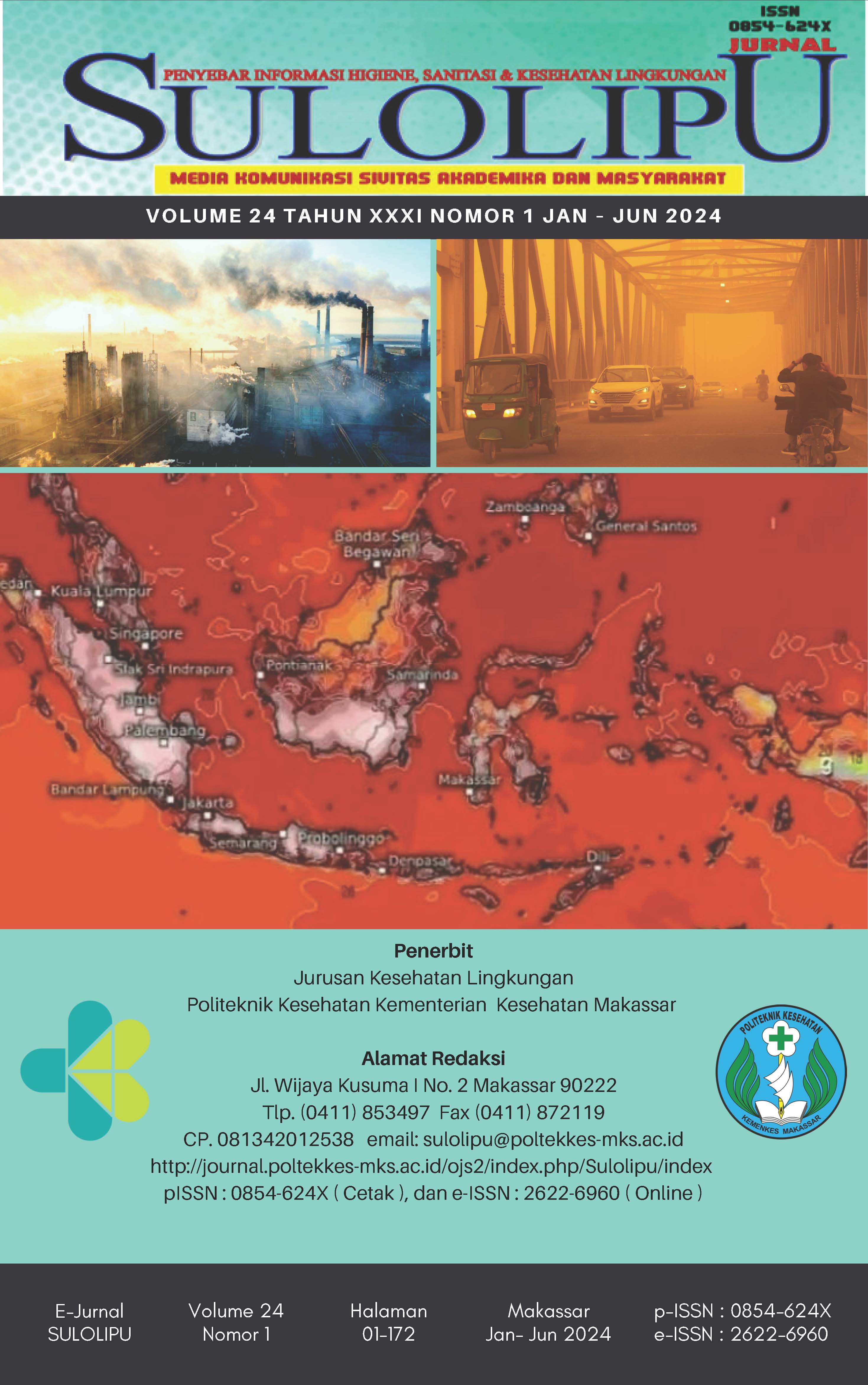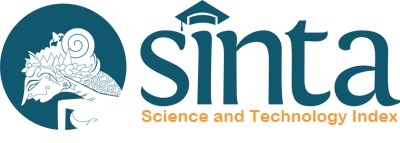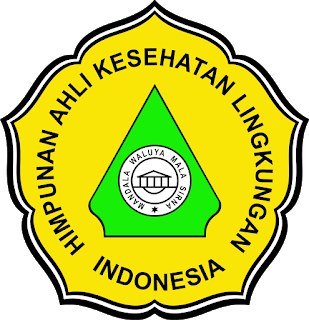Effectiveness Test of the Utilization of Papaya Seeds (Carica Papaya L) Dry and Wet as a Liquid Natural Larvicide to Kill Aedes Aegypti Larvae
DOI:
https://doi.org/10.32382/sulo.v24i1.476Keywords:
Biji Pepaya , Larva , Aedes aegyptiAbstract
Scarlet fever or dengue fever is an infectious disease in the tropics area that is caused by the dengue virus and transmitted by the Aedes aegypti mosquito One of the plants which can be utilized as natural larvicide is papaya seeds (Carica papaya L). The wet and dry papaya seeds are used in this research. The papaya seeds contain toxic compounds, they are alkaloids, flavonoids, saponins, and tannins. These compounds can inhibit the growth of Aedes aegypti larvae. This research is quasi-experimental. It aims to find out the effectiveness of the dry and wet papaya (Carica Papaya L) seed solvents with doses of 20 ml / Litre, 30 ml / Litre, 40 ml / Litre 50 ml / Litre, and 60 ml / Litre. The control was exposed to 20 Aedes aegypti larvae at each dose with observations every 60 minutes for 24 hours with the time intervals, the replication was carried out three times.The result shows that the mortality rate of Aedes aegypti larvae in the solvents of dry papaya seeds is the control no one dies (0%) doses of 20 ml can turn off (95%), 30 ml can turn off (100%), 40 ml can turn off (100%), 50 ml can turn off (100%), 60 ml can turn off (100%), , meanwhile, the solvents of wet papaya seeds are the control no one dies (0%) doses of 20 ml can turn off (100%), 30 ml can turn off (100%), 40 ml can turn off (100%), 50 ml can turn off (100%), 60 ml can turn off (100%). In a conclusion, a dose of 20 ml is the most effective dose as a liquid to kill Aedes aegypti larvae. Sugestions for the public to use wet papaya seeds as larvicide and for future researchers to use a dip bag and the dose used can be lowered by using wet papaya seeds.
Keywords : Aedes aegypti Larvae, Papaya Seeds (Carica Papaya L)
References
Asmira, & Sulasmi. (2019). Efektivitas Serbuk Biji Pepaya (Carica Papaya) Dan Tawas Dalam Mengendalikan Jentik Nyamuk Aedes Aegypti. Jurnal Edudikara, 19.
Ayun, A. Q., Faridah, D. N., Yuliana, N. D., & Andriyanto, A. (2021). Pengujian Toksisitas Akut LD50 Infusa Benalu Teh (Scurrula sp.) dengan Menggunakan Mencit (Mus musculus). Acta VETERINARIA Indonesiana,9(1),53–63.Online. https://doi.org/10.29244/avi.9.1.53-63 Diakses pada tanggal 10 Desember 2023
Baki, J. S., & Tengah, J. (2022). Sekolah Tinggi Ilmu Kesehatan Nasional Jurnal BUDIMAS ( ISSN : 2715-8926 ). 04(01), 1–6.
Dewangga, vector stephen, Qurrohman, muhammad taufiq, Tamba, nourma priska dianggi, Vera, T., Maharani, arista dhea, Pratiwi, G., & Indah, K. (2022). Edukasi Manfaat Lilin Kayu Manis Sebagai Anti Nyamuk Di Kelurahan Pucang Sawit. 04(01), 1–6.
Hidayani, W. R. (2020). Demam Berdarah Dengue : Perilaku Rumah Tangga Dalam Pemberantasan Sarang Nyamuk Dan Program Penanggulangan Demam Berdarah Dengue (1st ed.). CV. Pena Persada. Banyumas Jawa Tengah.1-6
Hikmawa, I., & Huda, S. (2021). Peran Nyamuk Sebagai Vektor Demam Berdarah Dengue (Dbd) Melalui Transovarial (1st ed.) Satria Publisher, Jawa Tengah, 25-36
Laksana. Wurdiana Shinta, L. E. (2019). Efektivitas Serbuk Biji Pepaya (Carica Papaya) Dan Tawas Dalam Mengendalikan Jentik Nyamuk Aedes Aegypti. Jurnal Edudikara, 19.
La Taha, & Inang, N. (2018). Kemampuan Ekstrak Daun Pepaya (Carica Papaya L.) Untuk Mematikan Larva Nyamuk Aedes Aegypti Dan Culex Sp. 06(1), 68–72.
Ngadino, Marlik, & Nurmayanti, D. (2021). Monograf Resistensi Nyamuk Aedes Aegypti Terhadap Cypermethrin (1st ed.). Jurusan Kesehatan Lingkungan Poltekkes Kemenkes Surabaya.Surabaya 12-14
Ninik Mas Ulfa, Galuh Kondo Kusumo, L. M. Z. (2018). Farmakologi-Farmakognosi Terapan Biji Pepaya Sebagai Alternatif Anti Kanker Payudara.Online. https://play.google.com/store/books/details?id=bTUPEAAAQBAJ, Kota Baru Driyorejo.36-39 Diakses pada tanggal 10 Desember 2022.
Nurlinawati, & Mulyani, S. (2020). Efektivitas ekstrak biji pepaya (Carica Papaya), filtrat daun sirsak (Annona Muricata), larutan daun tembakau (Nicotiana Tabacum) dan bubuk temefos 1% (abate) terhadap mortalitas jentik nyamuk Aedes aegypti. JMJ, Special Issues, JAMHESIC 2020, 8, 24–33.
Pramawati, A., Kafit, M., Martha, E., Candra, R. Z., Studi, P., Lingkungan, K., Kesehatan, F. I., & Sina, U. I. (2020). Perbandingan Efektivitas Abate Dengan Bubuk Biji Pepaya (Carica Papaya Linnaeus) Dalam Menghambat Larva Nyamuk Aedes Aegypti. 6(2).
Peraturan Menteri Kesehatan Republik Indonesia Nomor 2 Tahun 2023 Tentang Peraturan Pelaksanaan
Peraturan Pemerintah Nomor 66 Tahun 2014 Tentang Kesehatan Lingkungan. (2017). 123–124.
PURNAMA, S. G. (2017). Diklat Pengendalian Vektor (1st ed.). Universitas Udayana Program Study Ilmu Masyarakat Fakultas Kedokteran, Bali,7-15.
Putri, L. M. A., Prihandono, T., & Supriadi, B. (2017). Air adalah suatu zat kimia yang penting bagi semua bentuk kehidupan yang diketahui sampai saat ini di bumi ,. Jurnal Pembelajaran Fisika, 6(2), 147–153.
Yasi, R. M., & Harsanti, R. S. (2018). Uji Daya Larvasida Ekstrak Daun Kelor (Moringa aloifera Terhadap Mortalitas Larva (Aedes aegypti). Journal of Agromedicine and Medical Sciences, 4(3), 159. Online.https://doi.org/10.19184/ams.v4i3.8710 Diakses pada tanggal 10 Desember 2023
Downloads
Published
How to Cite
Issue
Section
PDF (Bahasa Indonesia) downloaded: 680



















